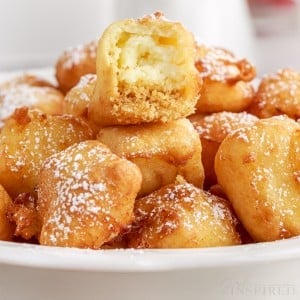
Fried Cheesecake
These deep fried cheesecake bites are the perfect finger food dessert, are easy to make, and uses frozen cheesecake as a time saver!
Ingredients
- 1 frozen cheesecake approx. 1 lb.
- 1 cup Bisquick pancake mix
- ½ cup milk
- 1 large egg
- ¼ cup powdered sugar
- Caramel sauce and/or strawberry sauce for serving
Instructions
- Remove frozen cheesecake from packaging and cut into pieces. The pieces should be approximate squares. If the crust is crumbling away from the cheesecake, it may be best to trim the crust off the pieces as well. (see note) Keep cheesecake pieces frozen while preparing the rest of the recipe.
- Fill a deep skillet or Dutch oven with several inches of cooking oil, such as vegetable oil or canola oil. Keep a candy thermometer in the oil to monitor the temperature. Heat the oil until it reaches 375°F; maintain the oil temperature between 350°F and 375°F throughout cooking.
- While the oil is heating, prepare the batter by whisking together the pancake mix, milk, and one egg until well combined. The batter should be thick enough to coat the cheesecake pieces while still allowing you to drip off the excess and work quickly.
- Dip one piece of cheesecake at a time into the batter. Use a fork to toss the cheesecake in the batter and then lift the piece out and allow excess batter to drip off. Immediately transfer the battered cheesecake into the hot oil.
- Flip the cheesecake occasionally while frying to ensure even cooking. Remove the cheesecake from the oil when it is golden brown all over - about 1-2 minutes.
- Blot excess oil from the fried cheesecake by placing on several layers of paper towels.
- Continue battering and frying all of the cheesecake pieces. Dust cheesecake pieces with powdered sugar.
- Drizzle sauces over the cheesecake bites or serve alongside as dipping sauces.
Would you like to save this?
Notes
- Depending on the cheesecake your purchase, the size may vary. The thickness may vary as well. I like to cut the pieces into squares so if your cheesecake is thicker, your overall square pieces will be larger than a shorter cheesecake. The process and time for cooking the fried cheesecake pieces, and the recipe for the batter, should not vary regardless of the size of your pieces.
- Some cheesecakes are made with a more crumbly crust. When you batter this crust, it tends to crumble into the pancake batter and gets messy. For these types of cheesecakes, most people will just cut the crust off also and simply batter and fry the cheesecake portion. I’ve also worked with cheesecakes where the crust stays intact and there is no crumbling issue. Personally, I think the star of the show is the cheesecake itself when deep fried, so with or without crust isn’t particularly relevant.
- If you’re having trouble transferring the battered cheesecake from the batter to the oil, lift with one fork (drain excess batter) and then use a second fork to swipe the battered bite from the fork to the oil.
- You can fry several pieces of cheesecake at a time; don’t overcrowd. You need the cheesecake pieces to have enough room so that you can turn them to cook evenly and remove them when done.
- You can use any pancake mix to make the batter. Mix batter up according to the instructions on the box and then use it to batter your cheesecake. If you find that your batter is too thick, add a teaspoon or so of milk at a time to thin. If you need to thicken up the batter, just add a bit more pancake mix until it’s thick enough to coat and stick to the cheesecake.
Nutrition
Calories: 339kcal | Carbohydrates: 43g | Protein: 8g | Fat: 16g | Saturated Fat: 7g | Polyunsaturated Fat: 1g | Monounsaturated Fat: 2g | Trans Fat: 0.02g | Cholesterol: 76mg | Sodium: 442mg | Potassium: 70mg | Fiber: 1g | Sugar: 25g | Vitamin A: 342IU | Vitamin C: 0.1mg | Calcium: 120mg | Iron: 1mg
Make this recipe?
Share it with me on Instagram @girlinspired1 and follow on Pinterest for more!